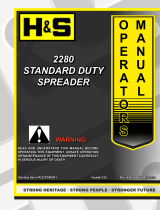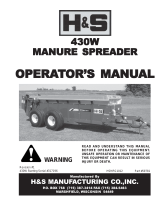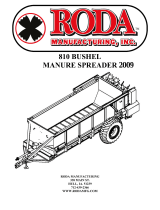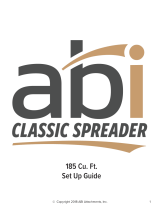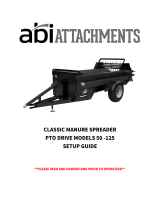Page is loading ...

Manufactured By
H&S MANUFACTURING CO.,INC.
P.O. BOX 768 (715) 387-3414 FAX (715) 384-5463
MARSHFIELD, WISCONSIN 54449
WARNING
Revision #00
3156 Starting Serial #710114
3166 Starting Serial #710068 HSMFG0517 Part #77530
READ AND UNDERSTAND THIS MANUAL
BEFORE OPERATING THIS EQUIPMENT.
UNSAFE OPERATION OR MAINTENANCE OF
THIS EQUIPMENT CAN RESULT IN SERIOUS
INJURY OR DEATH.
3156/31663156/3166
3156/31663156/3166
3156/3166
OPERAOPERA
OPERAOPERA
OPERATT
TT
TOR’S MANUOR’S MANU
OR’S MANUOR’S MANU
OR’S MANUALAL
ALAL
AL
Heavy Duty
Spreader

Warranty & Warranty Registration Card . . . . . . . . . . . . . . . . . . . . . . . . . . . . . . . . . . . . . . . . . . . . . . . 1-2
Dealer Pre-Delivery Checklist . . . . . . . . . . . . . . . . . . . . . . . . . . . . . . . . . . . . . . . . . . . . . . . . . . . . . . . . . 3
Dealer Delivery Checklist . . . . . . . . . . . . . . . . . . . . . . . . . . . . . . . . . . . . . . . . . . . . . . . . . . . . . . . . . . . . . 5
Safety Information - Be Alert Symbol . . . . . . . . . . . . . . . . . . . . . . . . . . . . . . . . . . . . . . . . . . . . . . . . . . . . 7
Safety Information - Explanation of Safety Signs . . . . . . . . . . . . . . . . . . . . . . . . . . . . . . . . . . . . . . . . . . 8
Safety Decals . . . . . . . . . . . . . . . . . . . . . . . . . . . . . . . . . . . . . . . . . . . . . . . . . . . . . . . . . . . . . . . . . . . . 9-10
Safety Information - Warning - Owner Must Read and Understand . . . . . . . . . . . . . . . . . . . . . . . . . . . 11
Cap Screw Torque Values . . . . . . . . . . . . . . . . . . . . . . . . . . . . . . . . . . . . . . . . . . . . . . . . . . . . . . . . . . . . 12
Set-Up & Assembly . . . . . . . . . . . . . . . . . . . . . . . . . . . . . . . . . . . . . . . . . . . . . . . . . . . . . . . . . . . . . . . . . 13
Transporting . . . . . . . . . . . . . . . . . . . . . . . . . . . . . . . . . . . . . . . . . . . . . . . . . . . . . . . . . . . . . . . . . . . . . . . . 13
Preparing For Operation . . . . . . . . . . . . . . . . . . . . . . . . . . . . . . . . . . . . . . . . . . . . . . . . . . . . . . . . . . 14-15
Operation . . . . . . . . . . . . . . . . . . . . . . . . . . . . . . . . . . . . . . . . . . . . . . . . . . . . . . . . . . . . . . . . . . . . . . . . . . 16
Adjustments . . . . . . . . . . . . . . . . . . . . . . . . . . . . . . . . . . . . . . . . . . . . . . . . . . . . . . . . . . . . . . . . . . . . . 17-18
Service . . . . . . . . . . . . . . . . . . . . . . . . . . . . . . . . . . . . . . . . . . . . . . . . . . . . . . . . . . . . . . . . . . . . . . . . . 19-20
Optional Equipment . . . . . . . . . . . . . . . . . . . . . . . . . . . . . . . . . . . . . . . . . . . . . . . . . . . . . . . . . . . . . . . . . . 21
Lubrication Guide . . . . . . . . . . . . . . . . . . . . . . . . . . . . . . . . . . . . . . . . . . . . . . . . . . . . . . . . . . . . . . . . 22-24
Decal Location . . . . . . . . . . . . . . . . . . . . . . . . . . . . . . . . . . . . . . . . . . . . . . . . . . . . . . . . . . . . . . . . . . 25-28
Trouble Shooting . . . . . . . . . . . . . . . . . . . . . . . . . . . . . . . . . . . . . . . . . . . . . . . . . . . . . . . . . . . . . . . . . . . . 29
Service Notes . . . . . . . . . . . . . . . . . . . . . . . . . . . . . . . . . . . . . . . . . . . . . . . . . . . . . . . . . . . . . . . . . . . . . . 30
Specifications . . . . . . . . . . . . . . . . . . . . . . . . . . . . . . . . . . . . . . . . . . . . . . . . . . . . . . . . . . . . Inside Back Cover
CONTENTS



Manure spreader was not damaged in shipment. Check for dents and loose or missing
parts. Report damage immediately to H&S Manufacturing Co., Inc.
All bolts and fasteners are tight.
Manure spreader has been correctly assembled according to instructions in this manual.
All grease fittings have been lubricated. Gearbox is filled to proper level.
Hoses and fittings are properly attached and there are no visible leaks.
Guards and shields are secure.
Wheels are properly mounted to torque specifications.
Tires are inflated to correct pressure.
Drive chain tension and alignment is correct.
Decals are in place and legible.
Main apron chains are adjusted properly.
DEALER PRE-DELIVERY CHECK LIST
AFTER COMPLETION, DEALER SHOULD REMOVE AND RETAIN FOR RECORDS
After the Manure Spreader has been completely set-up, check to be certain it is in correct operating order
before delivering to the customer. The following is a list of points to inspect. Check off each item as you
have made the proper adjustments and found the item operating satisfactorily.
Connect the manure spreader onto a proper horsepower tractor and attach the PTO and connect
the lights. Connect the hydraulic hoses to the tractor remote outlets. Run the manure spreader
and make sure all components operate properly.
PTO guard turns freely.
Hydraulic end gate operates smoothly.
Main apron operates smoothly.
Hydraulic system does not leak under pressure.
Lights and wiring functioning properly.
Implement and all components are functioning properly.
(Remove Dealer File Copy At Perforation)
Serial #
Dealer’s Name
Signature of Pre-Delivery Inspector
Inspection Date
Model Number
-3-

Intentionally Left Blank
-4-

This check list that follows is an important reminder of valuable information that should be passed
on to the customer at the time this Manure Spreader is delivered.
Check off each item as you explain it to the customer.
This delivery check list, when properly filled out and signed assures the customer that the
Pre-delivery service was satisfactorily performed.
Explain to the customer that the pre-delivery inspection was made.
Explain to the customer all the safety precautions they must exercise when operating
this unit.
Explain recommended loads for different types of materials.
Explain to customer that regular lubrication is required for proper operation and long life of
machine.
Show customer the lubrication section of Owner’s Manual.
Give the customer Owner’s Manual and make sure they read and understand all operating
and service instructions.
Have the customer sign a completed “Warranty Registration”, and mail it.
DEALER DELIVERY CHECK LIST
(Remove Dealer File Copy At Perforation)
AFTER COMPLETION, DEALER SHOULD REMOVE AND RETAIN FOR RECORDS
Date Delivered
Dealer’s Name
By
Signature of Original Buyer
Note: Warranty is not valid until warranty card is completed and returned to H&S Mfg. Co., Inc.
-5-

Intentionally Left Blank
-6-

BE
ALERT! YOUR SAFETY
IS INVOLVED.
THIS SYMBOL IS USED THROUGHOUT THIS BOOK WHENEVER YOUR PERSONAL SAFETY
IS INVOLVED. TAKE TIME TO BE CAREFUL. REMEMBER: THE CAREFUL OPERATOR IS THE
BEST OPERATOR. MOST ACCIDENTS ARE CAUSED BY HUMAN ERROR. CERTAIN
PRECAUTIONS MUST BE OBSERVED TO PREVENT THE POSSIBILITY OF INJURY OR
DAMAGE.
-7-
H&S MANUFACTURING CO., INC.
SAFETY INFORMATION

-8-
RECOGNIZE SAFETY INFORMATION
This is the safety-alert symbol. When you see this
symbol on your machine or in this manual, be alert to the
potential for personal injury.
Follow recommended precautions and safe operating
practices.
UNDERSTAND SIGNAL WORDS
A single word; DANGER, WARNING, or CAUTION is used
with the safety-alert symbol. DANGER identifies the most
serious hazards.
Safety signs with signal word DANGER or WARNING are
typically near specific hazards.
General precautions are listed on CAUTION safety signs.
FOLLOW SAFETY INSTRUCTIONS
Carefully read all safety messages in this manual, and all safety signs on your machine. Follow all
recommended precautions and safe operating procedures.
OBSERVE MAXIMUM TRANSPORT SPEED
The maximum transport speed for this implement is 32 km/h (20 m.p.h.).
Some tractors are capable of operating at speeds that exceed the maximum
transport speed of this implement. Regardless of the maximum speed capability
of the tractor being used to tow this implement, do not exceed the implement’s
maximum transport speed.
Exceeding the implements maximum transport speed can result in:
* Loss of control of the tractor/implement combination
* Reduced or no ability to stop during braking
* Implement tire failure
* Damage to the implement structure or its components
Use additional caution and reduce speed when towing under adverse surface
conditions, when turning, and when on inclines.
Do not attempt transport if the fully loaded implement weighs more than 1.5 times
the weight of the tractor.
Keep signs in good condition. Immediately replace any missing or damaged signs.
SAFETY INFORMATION

-9-
SAFETY INFORMATION

-10-
SAFETY INFORMATION

-11-
TO PREVENT SERIOUS INJURY OR DEATH
BEFORE YOU ATTEMPT TO OPERATE THIS EQUIPMENT, READ AND STUDY THE FOLLOWING
INFORMATION. IN ADDITION, MAKE SURE THAT EVERY INDIVIDUAL WHO OPERATES OR WORKS
WITH THIS EQUIPMENT, WHETHER FAMILY MEMBER OR EMPLOYEE, IS FAMILIAR WITH THESE
SAFETY PRECAUTIONS.
KNOW HOW TO STOP UNLOADING MECHANISM BEFORE STARTING IT.
If the machine becomes clogged, disengage the PTO. Stop the tractor engine, remove ignition key,
and allow all mechanisms to stop before cleaning or working on the machine.
DO NOT get off the tractor while the Manure Spreader is in operation.
DO NOT attempt to perform maintenance or repair with tractor running and PTO or hydraulic lines
hooked up.
DO NOT step up on machine at any time.
NEVER manually feed material into the beaters.
DO NOT allow minors to operate or be near the machine.
DO NOT ALLOW PERSONNEL OTHER THAN THE QUALIFIED OPERATOR NEAR THE MACHINE.
Before starting tractor, be sure PTO shields turn freely and PTO is securely locked to tractor.
DO NOT clean, adjust, or lubricate the machine when any part is in operation.
Keep hands, feet, and clothing away from beaters when they are revolving.
Loose or floppy clothing should not be worn by the operator.
Be sure the machine is clear of people, tools, and other objects before engaging PTO.
DO NOT step over power take off shaft. Stay clear of PTO at all times.
NEVER start Manure Spreader until all guards and safety shields are secured in place.
STAY CLEAR of Hydraulic Lines. They may be under extreme pressure or heat.
H&S always takes the operator and his safety into consideration and guards exposed moving parts for
his protection. However, some areas cannot be guarded or shielded in order to assure proper operation.
In addition, the operators manual and decals on the machine itself warn you of further danger and
should be read and observed closely.
TRACTOR:
This operators manual uses the term “Tractor” when identifying the power or the towing source.
SAFETY INFORMATION
Study The Above Safety Rules
ATTENTION - BE ALERT - YOUR SAFETY IS INVOLVED
WARNING

-12-

-13-
SET-UP & ASSEMBLY
PREPARING MANURE SPREADER
The Manure Spreader may be shipped without the wheels/tires installed.
1. Attach the wheels with tires, using the lug nuts furnished and torque the mounting hardware to
the appropriate torque. The wheel bolts must be tightened at 100 ft./lbs. of torque on the 3156,
and 300 ft./lbs. of torque on the 3166.
2. Check the tires and inflate them to the recommended pressure
3156/3166 - 425/65R-22.5 tires to 85 psi.
3156 - optional 600/50x22.5 tires to 38 psi.
3. Check for proper assembly and adjustment and make sure that all bolts are tightened.
4. Securely retighten after a few hours of operation, as bolts can loosen up on new machinery.
5. Lubricate the machine completely, check the oil level of the gearbox, fill if necessary.
TRANSPORT LIGHTING & REFLECTORS
When transporting on the highway, connect the spreader
to the tractor with a lighting power cord. The lighting
system is to be connected to the 7 pin power receptacle
(per SAEJ560B) on your tractor. If your tractor is not
equipped with the proper receptacle, see your tractor dealer
for details. Make sure lights are functioning properly.
Regularly clean the reflective tape at the rear of the
spreader. There is a holder provided for your SMV sign.
TRANSPORTING
SAFETY CHAIN (Optional)
Follow state and local regulations regarding use of a safety chain and transport lighting when towing farm
equipment on public highways. A proper safety chain should be used to retain the safety connection
between the towing and towed machines, in the event of separation of the primary attaching system.
Check with local law enforcement agencies for your own particular regulations. Unless otherwise prohibited,
use a slow-moving vehicle emblem. Never tow the manure spreader on a public highway at a speed
greater than 20 m.p.h. (32 kph).
1. Chain is sufficiently slack to allow turns and movements of either the tractor or the manure spreader,
without placing tension on the chain.
2. Chain is of sufficient strength to hold the decoupled implement (and its load) and tow it to the
shoulder.
Note: Determine right and left side of spreader by viewing it from the rear. If instructions
or parts lists call for hardened bolts, refer to Cap Screw Torque Value page to identify.

Tractor Hitch
Fasten the spreader hitch to the drawbar with a hitch pin with a safety locking device. Remove the
weight from the jack (jack is not to be used when spreader is loaded). Remove jack from the pipe mount
and place it on the storage mount located on the left front of spreader. This allows protection of the jack
from the tractor tires during turns. The hitch of the spreader is designed for a standardized tractor hitch.
Adjust the drawbar so that it is 13 to 17 inches above the ground. Extend or shorten it so that the
horizontal distance from the end of the tractor power takeoff shaft to the center of the hitch pin hole is 14
inches for 540 PTO and 15-3/4” for 1000 PTO as shown in drawing. An improperly located hitch point
may cause damage to the universal joints of the power takeoff. Secure the drawbar so that the hitch pin
hole is directly below the power drive line.
-14-
PREPARING FOR OPERATION
TRACTOR CONNECTIONS
If this implement is attached to a tractor with a clevis
hitch (hammer-strap) style drawbar, the hammer-strap
must be removed to prevent damage to the IID guarding
and the IID telescoping members. [See Figure 1]
If this implement is attached to a tractor with an offset in
the drawbar, be certain it is in the down position to
prevent damage to the IID guarding and the IID
telescoping members. [See Figure 2]
PTO
Attach the PTO of the spreader to the tractor by sliding the spring loaded locking collar on PTO yoke
rearward, then sliding it onto the tractor PTO shaft. Release the spring loaded collar. Be sure the pins
fall into the groove of the tractor PTO shaft and collar snaps forward into locking position.
CAUTION: Do not use a steel hammer to aid in joining PTO parts.
15-3/4” for 1000 RPM

-15-
PREPARING FOR OPERATION
Hydraulics
The spreader requires a 4 hose hook-up;
Connect the set of hydraulic hoses which operate the hydraulic endgate to a double acting valve on the
tractor.
Connect the set of hydraulic hoses which operate the spreader main aprons from the spreader to a
double acting valve on the tractor.
Securely mount the electrical speed control inside the tractor cab. Attach the pigtail to the tractor
electrical supply, either wired directly from the battery, or by connecting to the convenience plug.
Note: The Hydraulic Endgate must always be raised completely prior to activating the hydraulics
for the main apron.
Operate the tractor valve to fill the hydraulic lines and operate the cylinders. Add hydraulic fluid to the
tractor system, as required.
Before operation, run the machine slowly to make sure that the spreader is operating and lubricated
properly.

LOADING
Begin loading the spreader at the front end and work toward the rear until loading is completed. Loading
this way permits the material to be spread uniformly. Loading front to rear is particularly important when
the spreader is loaded by a mechanical loader because this type of load requires more power to spread
than other loads.
When hauling extremely heavy materials with a large portion of dirt, it may be necessary to reduce the
load size to prevent excessive shear bolt breakage. Never dump material onto the beater. Do not use
extra sideboards. Do not overload the Manure Spreader. Overloading decreases the spreading
effectiveness. Do not load more than 15 inches above the beater.
SPREADING
1. Engage the tractor PTO slowly. The beater is always in
the engaged position, therefore, engaging the tractor PTO
will automatically starts the beaters.
2. Raise the hydraulic endgate by engaging the tractor
hydraulics.
Note: The Hydraulic endgate MUST BE RAISED
COMPLETELY prior to engaging the hydraulic main
apron.
3. Engage the tractor hydraulic lever into the detent position
to operate the hydraulic drive main aprons.
4. Control the variable speed main apron by using the
cab-mounted electric control.
5. When the spreader is almost empty, the box can be
cleaned out by disengaging the tractor PTO (which will stop
the beater), and increasing the apron speed.
6. When the spreader is completely empty, return the apron
speed indicator to the stop position and engage the tractor
hydraulics to close the hydraulic endgate.
OPERATION
EMERGENCY SHUTDOWN
If a foreign object becomes lodged in the beater area and shears the shear bolt, disengage the PTO.
Stop the tractor engine, remove the ignition key, and allow all mechanisms to stop before cleaning or
working on the spreader.
WINTER OPERATION
In freezing weather, make certain that hydraulic tailgate is not frozen to the sides or on the floor of the
spreader. Make sure the apron chain is not frozen to the spreader floor or any lumps of manure are
frozen to the floor.
-16-
WARNING: Some photographs used in the following pages show guards or shields
are removed for clarification. NEVER operate the machine until these guards or shields
are in proper operating position.

FRONT DRIVE CHAIN
To adjust the front drive chain, loosen the jam nut and turn the nut on the adjusting rod (located at the right
hand front side of spreader) clockwise. There should be 1/2” deflection at the center of the drive chain.
Over tightening or too loose of a chain will result in excessive wear on the bearing, chain and sprockets.
After adjusting, lock with the jam nut.
ADJUSTMENTS
Apron Tightening Bolts
-17-
APRON
Tighten the four adjusting bolts (1 on each side of
spreader and the two below the input shaft shield)
equally so that the apron slats run parallel with the
ends of the bed. The apron will be damaged if the
machine is operated with one end of the apron
slats running ahead of the opposite end.
Adjust the tightener bolts equally on both sides of
each apron until (three) slats are lifted off of the
apron return slides at the front and rear of the
spreader.
APRON DRIVE
Check the apron drive chain regularly. To adjust, loosen the nut on the tightener and slide the tightener
against the chain until there is approximately 1/8” deflection in the center of the chain opposite the
tightener.
Shields Removed for Clarity
A
Front
Drive
Chain
Adjuster

Shields Removed for Clarity
ADJUSTMENTS
PRIMARY & SECOND BEATER DRIVE CHAINS
Both chains are spring loaded. Check both chains regularly to
maintain space between the coils of the springs. Adjust the “I” bolt
to increase spring tension. If the space between the coils of the
spring is not able to be maintained by adjusting the I-bolt, a link
may have to be removed in the main aprons to maintain proper
adjustment.
NOTE: PERIODICALLY LUBRICATE ALL ROLLER CHAINS
WITH A LIGHT MACHINE OIL.
BE SURE ALL SHIELDS ARE SECURED INTO
PLACE PRIOR TO RE-STARTING MACHINE.
-18-
ADJUSTING WHEEL HUBS
To adjust the wheel hubs, tighten the castellated nut on the spindle
to the point where there is no end-play and a slight drag on the
bearings. Replace the cotter key with a new one of the correct
size.
/
